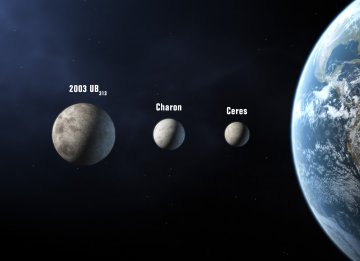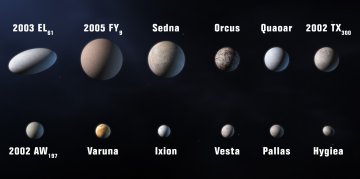Pluto and the plutons
A new definition would raise the number of planets in the solar system from 9 to 12.
By Emily Sohn
It’s a planet! No, it’s not! Yes, it is! No, it’s not!
It sounds like a schoolyard spat, but astronomers have been debating for years whether Pluto is truly a planet.
Many people want to keep Pluto in the planet family. So, astronomers are now considering a way to define “planet” so that Pluto remains one. But this means that other bodies in the solar system would also qualify to be called planets.
If the new definition is approved by astronomers, the official number of planets will go from 9 to 12. Eventually, there may be dozens more.
 |
|
A proposal now being discussed by astronomers provides a new definition of “planet” and raises the official number of planets in the solar system from 9 to 12, bringing Ceres, Charon, and 2003 UB313 (unofficially called Xena) into the family. In this illustration, Ceres, Pluto, Charon, and 2003 UB313 are not shown to scale.
|
| International Astronomical Union/Martin Kornmesser |
According to a panel of seven astronomers, writers, and historians, a planet is an object that orbits a star, but it is not itself a star or a satellite (moon) that orbits a planet. The object must also have enough gravity that its shape is round.
“We finally have a definition of a planet after 2,500 years,” says Neil deGrasse Tyson, director of the Hayden Planetarium in New York City. “I applaud any definition that gives us an unambiguous answer.”
 |
|
UB313 (Xena), Charon, and Ceres—proposed new additions to the solar system family of planets—are much smaller than Earth.
|
| International Astronomical Union/Martin Kornmesser |
For more than 75 years, textbooks have taught kids to memorize, in order from the sun, the names of the nine planets of the solar system: Mercury, Venus, Earth, Mars, Jupiter, Saturn, Uranus, Neptune and Pluto.
Then, in 1992, astronomers started finding large objects in the outer solar system—a region called the Kuiper belt, which lies beyond Neptune. The Kuiper belt contains nearly 1,000 objects, including Pluto.
Experts have debated Pluto’s status as a planet because, compared to other planets, Pluto is pretty weird. Its orbit is oddly shaped. It’s also smaller than its planetary peers. Then, last year, astronomers found an object in the belt that’s larger than Pluto. This object is called 2003 UB313 (unofficially named Xena).
No one seems willing to take away Pluto’s planethood. Instead, the panel suggests keeping Pluto and adding anything like Pluto to the list. One such object is Charon, presently considered Pluto’s moon. The panel suggests that Charon is big enough that Charon and Pluto together should count as a “double planet.” Charon has 15 percent the mass of Pluto.
Under the new proposal, 2003 UB313 would also become a planet. Along with Pluto and Charon, it would belong to a new group, called icy plutons.
 |
|
This illustration shows a number of bodies in the solar system that could yet qualify to be listed as planets.
|
| International Astronomical Union/Martin Kornmesser |
Scientists have discovered at least 41 objects at the edges of the solar system that would eventually become part of this group. There are probably many more icy plutons still waiting to found.
Some scientists worry that the new definition will confuse the public. Others just want to get the decision made and over with.
At a meeting of the International Astronomical Union (IAU) in late August, however, astronomers rejected the proposal. They voted instead to demote Pluto, leaving the solar system with eight true planets. Pluto becomes a “dwarf planet.”
The time has come to update astronomy textbooks.—E. Sohn
Going Deeper:
Cowen, Ron. 2006. New solar system? Twelve planets and counting. Science News 170(Aug. 19):115. Available at http://www.sciencenews.org/articles/20060819/fob1.asp .
______. 2006. Doggone! Pluto gets a planetary demotion. Science News 170(Sept. 2):149-150. Available at http://www.sciencenews.org/articles/20060902/fob6.asp .
The International Astronomical Union’s planet proposal is available at www.iau2006.org/mirror/www.iau.org/iau0601/iau0601_release.html (International Astronomical Union).
Sohn, Emily. 2006. Xena’s mysterious sparkle. Science News for Kids (April 19). Available at http://www.sciencenewsforkids.org/articles/20060419/Note2.asp .
______. 2006. Sizing up Pluto’s moon. Science News for Kids (Feb. 22). Available at http://www.sciencenewsforkids.org/articles/20060222/Note3.asp .
_____. 2005. Pluto’s new moons. Science News for Kids (Nov. 9). Available at http://www.sciencenewsforkids.org/articles/20051109/Note2.asp .
______. 2005. Solving a Sedna mystery. Science News for Kids (May 4). Available at http://www.sciencenewsforkids.org/articles/20050504/Note3.asp .
______. 2004. Icy orbs at the solar system’s edge. Science News for Kids (Dec. 1). Available at http://www.sciencenewsforkids.org/articles/20041201/Note2.asp .
______. 2004. Planets on the edge. Science News for Kids (April 7). Available at http://www.sciencenewsforkids.org/articles/20040407/Feature1.asp .
SciFiZone
http://www.sciencenewsforkids.org/articles/20040407/SciFiZone.asp







